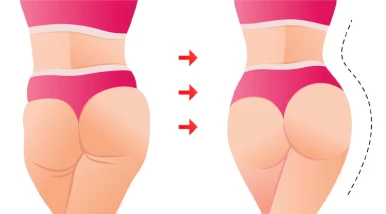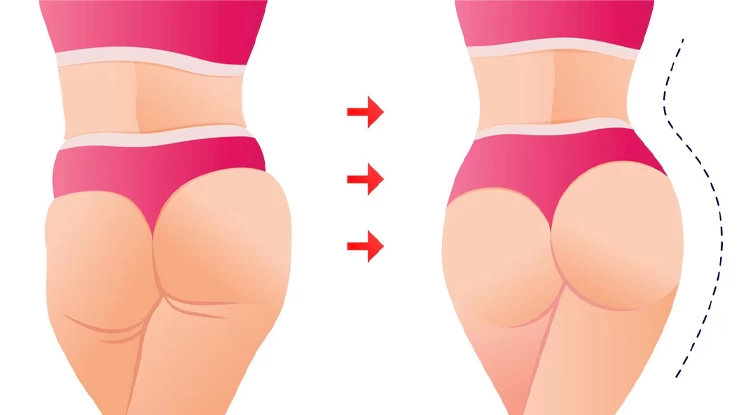Tips for a Successful Revision Brazilian Butt Lift: Procedure + Aftercares
Body Plastic Surgery
A Brazilian Butt Lift (BBL) surgery has become increasingly popular in recent years as more individuals seek to enhance their buttocks through fat transfer procedures. While the initial BBL procedure can significantly improve shape and volume, some patients may experience complications or unsatisfactory results that necessitate a BBL revision surgery.
These revisions may be required to correct asymmetry, address fat absorption, or improve overall aesthetic outcomes. Like the initial BBL procedure, a BBL reversal aims to improve and reshape the buttocks utilizing excess fat from neighbouring body areas.
In this article, we will explore the causes of a botched BBL and what a revision BBL entails. We will also explore why individuals may opt for the second BBL and the transformative benefits it can offer. Read on to learn more!
What Is a Revision BBL (Brazilian Butt Lift)?
A revision Brazilian Butt Lift (BBL) refers to a secondary or corrective procedure performed on a patient who has previously undergone a BBL but is not satisfied with the results. This may involve addressing issues such as unevenness, asymmetry, scarring, or other complications resulting from the initial surgery. A revision BBL aims to improve the aesthetic outcome and address any concerns or dissatisfaction the patient may have following the initial procedure.
What Is the Difference Between BBL and Double BBL?
In a Brazilian Butt Lift (BBL) surgery, fat is extracted from specific areas of the body and transferred to the buttocks to enhance their size and fullness. However, in a BBL revision, fat may be removed from the buttocks to reduce size or injected into one side to correct any asymmetry while adding volume.
A BBL revision surgery is more complex than an initial BBL operation due to factors like scar tissue, changes in buttock anatomy, and potential issues with previously transferred fat. This complexity can be further heightened if existing fat needs to be removed before new fat can be harvested and transferred. As a result, a Brazilian Butt Lift revision may require a longer duration than the initial procedure due to the precise surgical manoeuvres needed to address any asymmetry effective
How Can a BBL Go Wrong: Causes a Botched BBL?
A botched Brazilian Butt Lift (BBL) can occur due to a variety of reasons, including:
Inexperienced or unqualified surgeon
If the surgeon performing the BBL does not have the necessary experience, training, or qualifications, they may make mistakes during the BBL procedure, resulting in an unsatisfactory outcome.
Incorrect technique
The BBL procedure involves transferring fat from one body part to the buttocks. If the fat is not harvested, processed, or injected correctly, it can lead to asymmetry, lumps, or irregularities in the buttocks.
Complications during surgery
Like any surgical procedure, a BBL carries risks such as infection, bleeding, or anesthesia-related complications. These complications can lead to a botched BBL if not appropriately managed.
Inadequate post-operative care
Inadequate post-operative care, such as not following the surgeon's instructions for recovery, such as wearing compression garments, avoiding sitting or lying on the buttocks for a prolonged time, and avoiding any activities that can put pressure on the buttocks, can also contribute to a botched BBL.
Fat necrosis
Fat necrosis is a rare yet significant complication that can arise following a Brazilian Butt Lift (BBL) procedure. This condition occurs when the transferred fat cells die, leading to tissue damage. Factors contributing to fat necrosis include compromised blood supply to the transplanted fat or an infection.
Infection
Although uncommon, infections can potentially develop post-BBL or any surgical intervention. If an infection does occur after a BBL, it can result in severe complications, potentially necessitating further surgical interventions for resolution.
Patient-related factors
Some patient-related factors, such as obesity, smoking habits, overall health issues, and skin elasticity, can heighten the risk of complications and suboptimal outcomes following a BBL procedure.
Who Is a Candidate for a BBL Revision?
Good candidates for a BBL revision are individuals who have previously undergone a BBL surgery and are dissatisfied with the results or have experienced complications. Candidates need to be in good overall health and have realistic expectations about the outcomes of the BBL revision surgery. Some reasons for a BBL revision may include:
- Uneven or asymmetrical results;
- Insufficient volume or projection;
- Fat absorption or loss;
- Large excessive scarring;
- Complications such as infection, seroma, and fat necrosis;
- Healing issues.
How Long to Wait Before a Second BBL?
The timing for a revision Brazilian Butt Lift (BBL) procedure can vary depending on several factors, including the specific reasons for seeking a BBL reversal, the extent of the previous surgery, and your overall health and recovery. It is typically recommended that patients wait at least 6 to 12 months after the initial procedure before considering a BBL revision.
Waiting for this period allows the body to heal fully, the transferred fat to settle and stabilize, and any potential issues or complications from the initial surgery to become apparent. It also gives the plastic surgeon a better understanding of the results achieved from the first procedure and helps plan the revision surgery more effectively.
How Is a BBL Revision Procedure Performed?
During a Brazilian Butt Lift (BBL) revision surgery, the plastic surgeon will address any concerns or issues from the initial BBL procedure and work to enhance or improve the shape, size, symmetry, and overall appearance of the buttocks.
If additional fat transfer is needed during the revision surgery, fat may be harvested from donor areas such as the abdomen, flanks, or thighs using liposuction. The harvested fat is then processed to purify it before being injected into the buttocks.
Purified fat is carefully injected into specific areas of the buttocks to enhance volume, shape, and contour. The plastic surgeon then sculpts and shapes the buttocks to achieve the desired results, focusing on symmetry and proportion.
The plastic surgeon will address any complications or issues from the initial BEST-F procedure, such as fat absorption, asymmetry, or irregularities, during the revision procedure. This may involve correcting unevenness, revising previous fat injections, or addressing other concerns.
Once the fat transfer and sculpting are completed, the incisions are closed with sutures. The patient will be given post-operative instructions for recovery, including guidelines for sitting, sleeping positions, wearing compression garments, and caring for the surgical sites.
How Long Does It Take to Recover from a BBL Revision?
The recovery time for a Brazilian Butt Lift (BBL) revision can vary depending on factors such as the number of liposuction areas and the amount of harvested fat. Generally, the recovery process for a BBL revision is similar to that of the initial surgery.
Patients typically experience swelling, bruising, and discomfort following a BBL revision in the first few weeks. To facilitate proper healing and minimize complications, it is essential to follow your surgeon's post-operative instructions carefully.
Most patients can expect to return to light activities within three weeks after a BBL revision. However, it may take at least six months for the final results to become fully apparent as swelling subsides and the body adjusts to the changes.
What Are the Brazilian Butt Lift Revision Aftercare?
Post-operative care for a BBL is crucial to ensure optimal results and minimize complications. Here are some bbl aftercare key points to consider:
Compression garments after BBL
Patients should wear compression garments as instructed by their surgeon. These garments help reduce swelling, provide support, and shape the buttocks. It's important to strictly follow the recommended duration and instructions for wearing these garments.
Wound care
Proper wound care is essential to prevent infection and ensure proper healing. Patients should keep the incision sites clean and dry. They may be advised to clean the wounds with mild soap and water, gently pat them dry, and apply any prescribed ointments.
Pain management
It's common to experience pain and discomfort after a BBL. Patients should take any prescribed pain medications as directed and report any severe pain or unusual symptoms to their surgeon.
Limit sitting and lying directly on the buttocks
Sitting or lying directly on the buttocks can negatively impact the transferred fat cells' survival. Patients should avoid sitting after bbl for at least two weeks, or as advised by their surgeon. Instead, they can use a BBL pillow or cushion to sit on their thighs or lay on their stomachs.
Hydration and nutrition
Staying hydrated and maintaining a balanced diet are important for optimal healing. Drinking plenty of water and eating nutritious foods rich in vitamins and minerals can aid in recovery.
Avoid strenuous activities
Patients should avoid any strenuous activities or exercise that may put pressure on the buttocks for at least six weeks. Light walking is usually encouraged to promote blood circulation and reduce the risk of blood clots.
Follow-up appointments
Regular follow-up appointments with the surgeon are necessary to monitor healing progress and address any concerns. These appointments may include removing stitches, assessing the results, and providing further instructions for recovery.
What Are the Pros and Cons of A BBL Revision?
The pros of a BBL revision surgery can include:
- Corrected imperfections - A revision BBL surgery can address asymmetry, contour irregularities, or other aesthetic concerns that may not have been fully resolved in the initial surgery;
- Enhanced results - By redistributing fat or adding more volume, a revision BBL can help achieve a more desired outcome and improve the overall appearance of the buttocks;
- Addressing complications - If there were any complications from the initial BBL surgery, such as fat absorption or uneven results, revision surgery can help correct these issues and improve the overall outcome;
- Improved Fat Survival Rate - During a revision procedure, the injected fat typically has a higher chance of survival compared to the original BBL. This is often due to the surgeon having more space in the buttocks and hips to distribute the fat, creating a less congested environment for the fat cells;
- Minimal Scarring - Revisions can frequently utilize the existing scars from the initial surgery. If a new donor site is necessary, scarring is typically minimal;
- Immediate, Visible Results - Unlike attempting to reshape the buttocks through exercise alone, a BBL revision delivers rapid and noticeable transformations.
The negatives of a BBL revision may be as follows:
- Increased complexity - Revision BBL surgeries can be more challenging than initial surgeries due to factors like scar tissue, changes in anatomy, and potential limitations in available fat for transfer;
- Higher risk of complications - Any surgical procedure carries risks, and undergoing a revision BBL surgery may increase the risk of complications such as infection, bleeding, or poor wound healing;
- Longer recovery time - Because revision BBL surgeries are often more involved than initial surgeries, the recovery time may be longer, and the post-operative care may require more attention;
- Additional cost - Having a revision BBL surgery will incur additional costs for the surgical procedure, anesthesia, facility fees, and post-operative care, which should be taken into consideration;
- Wait time - It is recommended that patients wait a minimum of 6 to 9 months following the initial BBL procedure before considering a revision. This allows for the scar tissue from the first surgery to soften and resolve, optimizing the outcome of the BBL revision.
What Are the Risks and Complications of a BBL Revision?
Some potential risks and complications associated with a Brazilian Butt Lift (BBL) revision surgery include:
- Infection - Infections can occur after any surgical procedure, and it is important to follow post-operative care instructions to minimize this risk.
- Poor wound healing - Some patients may experience delayed wound healing or wound breakdown, which can lead to infection or other complications.
- Fat necrosis - This is the death of fat cells, which can lead to the formation of hard lumps or nodules in the buttocks.
- Asymmetry - Despite efforts to achieve symmetry during the revision surgery, there is a risk of uneven results between the two buttocks.
- Fluid accumulation - Seromas or hematomas can develop after surgery, causing swelling, pain, and potential infection if not properly managed.
- Scarring - While efforts are made to minimize scarring, some patients may develop visible scars at the incision sites.
- Changes in sensation - Some patients may experience changes in sensation in the buttocks or surrounding areas after surgery.
- Blood clots - There is a risk of developing blood clots in the legs (deep vein thrombosis) or lungs (pulmonary embolism) after any surgery, including BBL revisions.
How Much Does A BBL Revision Cost in Iran?
The cost of a Brazilian Butt Lift (BBL) revision in Iran can vary depending on various factors such as the specific clinic or surgeon you choose, the extent of the revision needed, and any additional procedures that may be required. On average, the cost of a BBL revision in Iran can range from $2,000 to $4,000.
Why BBL in Iran?
With a reputation for excellence in cosmetic surgery and a focus on patient satisfaction, Iran is a top destination for individuals considering a BBL. Iran boasts a wealth of highly skilled and experienced plastic surgeons who specialise in cosmetic surgeries, including BBL. These professionals are well-trained and have access to state-of-the-art facilities, ensuring the highest safety and quality of care.
Additionally, BBL procedures like BBL revision in Iran are significantly more affordable compared to many other countries, making it a cost-effective option for individuals looking to enhance their buttocks. Moreover, Iran's strong cultural emphasis on beauty and aesthetics means that the country has developed a reputation for delivering exceptional results in cosmetic procedures, including BBLs.
Is a BBL Revision Worth It?
BBL revisions are gaining popularity as a sought-after cosmetic enhancement procedure, particularly because the buttocks are a focal point for individuals seeking to enhance their overall physique. Many patients find that undergoing a BBL revision with a skilled and seasoned surgeon proves to be a valuable investment, as it helps them attain the desired outcome they initially sought.
FAQ About BBL Revision
Will weight loss undo a BBL?
A BBL involves transferring fat from other body areas to the buttocks to enhance shape and size. If a significant amount of weight is lost after a BBL, the transferred fat cells may shrink, reducing the size and projection of the buttocks.
Is BBL revision more painful?
Revision surgery is more challenging as it involves addressing previous procedures. Some people may find the revision to be more painful than the initial BBL because there might be scar tissue present, and the body may have already experienced trauma from the first procedure. However, pain management techniques can help alleviate post-operative pain and discomfort.
How many BBLs can you get?
You can undergo multiple BBLs as long as enough body fat is available for harvesting. However, it is recommended that you wait at least six months, preferably a year, before considering another procedure.
What happens to BBL after 20 years?
The BBL results could last for several decades, eliminating the necessity for further interventions. However, some patients may undergo a lift procedure in their older years to counteract sagging caused by the natural ageing process.
What is the most common complication of BBL?
The most common complication of Brazilian Butt Lift (BBL) is fat embolism. A fat embolism occurs when fat particles are unintentionally injected into the bloodstream during the procedure, which can then travel to other parts of the body, such as the lungs or brain, and cause serious complications.



 WhatsApp
WhatsApp
 Telegram
Telegram
 Facebook
Facebook
 Email
Email






No reviews
Your comment